|
|
Original Problems (page 3)I’ll publish some of my problems here and I’d be happy to receive yours! Diagrams, comments, new ideas, anything to discuss – are very appreciated! The site is mostly about fairies, but h# and s# are also welcome! Please send your problems to my e-mail: julia@juliasfairies.com Go to >>> Page 2 ; >>> Page 4 |
I’m happy to show you the first original problems I’ve got right after the publication of IGM P.Petkov’s article BLOCK OF NEUTRAL BATTERY-PIECE (Part II):
No.9 – s#2 by Juraj Lörinc
No.10,10(b) – h#2** by János Mikitovics
No.10.1 – h#2* by János Mikitovics & Juraj Lörinc – an improved version to No.10, shown in the comment by J.Lörinc.
No.11 – h#2 by Dmitri Turevski
Definitions:
Locust (L): moves on Q-lines but only by capturing an enemy unit, arriving on the square immediately beyond that unit, which must be vacant.
Rook-Locust (LR): Moves like Locust, but on Rook-lines only.
Bishop-Locust (LB): Moves like Locust, but on Bishop-lines only.
PAO(PA): Moves as Rook, but captures only by hopping over a hurdle to any square beyond.
Giraffe(GI): Piece from S- type, or so called Leaper (1,4) – for example: Gia1 can play on b5 and e2
LEO(LE): Moves as Queen, but captures only by hopping over a hurdle to any square beyond.
Double Grasshopper(DG): Makes a Grasshopper move without capturing, then a 2nd Grasshopper move.
Grasshopper(G): Moves along Q-lines over another unit of either color to the square immediately beyond that unit. A capture may be made on arrival, but the hurdle is not affected.
Kangaroo-Lion(KL): Moves along Q-lines over 2 hurdles of either color (which may or may not stand on adjacent squares) to any square beyond the 2nd unit. A capture may be made on arrival, but the hurdle is not affected.
|
–
No.9 Juraj Lörinc
(Slovakia)
original
–
 s#2 (7+4+3)
White Locusts: c8, e8
Black Locusts: b1, e1
Neutral Locusts: d5, d6, g7
White PAO d3
–
Solution:
1…nLg7*f6-e5 b 2.nLd5*d6-d7+ A nLd7*d3-d2#
1.f6-f7 ?
threats 2.nLd5*d6-d7+ A nLd7*d3-d2#
1…nLg7*g5-g4 a 2.nLd6*d5-d4+ B nLd4*d3-d2#
1…nLg7*f7-e7 !
1.f4-f5 ! threat:
threats 2.nLd6*d5-d4+ B nLd4*d3-d2#
1…nLg7*g5-g4 a 2.nLd5*d6-d7+ A nLd7*d3-d2#
1…nLg7*f6-e5 b 2.nLd6*e5-f4+ C nLd5*d3-d2#
–
Le Grand theme based on the blocking of arrival squares of neutral locusts.
Additionally, set mate is both changed and transferred in the solution.
nLg7 could be theoretically black, however this would decrease the value of Le Grand theme (and position overall) as there would be prepared set line 1…Lg7*g5-g4 2.nLd5*d6-d7+ as nLd7 would not be able to capture bLg4 as an answer.
Naturally, locusts were used for very economical and relatively open construction. Maybe it could be improved.
Note that although there is always the same mating net around wK, there are 3 different mating moves used (with departure squares d4, d7 and d5).
Another interesting point is that almost everything works also with wPg5->g6 and nLg7->g4, just the set play is ruined, thus the choice of position for now. (Author)
|
–
No.10 János Mikitovics
(Hungary)
original
–
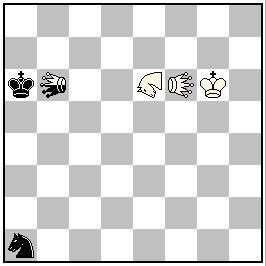 h#2** b) wKg6->d6 (3+2+1)
White Giraffe e6; Lion f6
Neutral Locust b6
–
Solution:
a)
1…Kg8-g7 2.Sa1-b3 nLb6*b3-b2 #
1.Sa1-c2 Kg8-f7 2.Sc2-b4 nLb6*b4-b3 #
b)
1…Kd6-e5 2.Sa1-b3 nLb6*b3-b2 #
1.Sa1-c2 Kd6-d5 2.Sc2-b4 + nLb6*b4-b3 #
–
Easy miniature from Petko A. Petkov’s idea, problem No.9 in the article “Block of neutral battery-piece”, part 2. (Author)
|
|
–
No.10(b) János Mikitovics
(Hungary)
original, version of No.10
–
 h#2* (3+2+1)
White Giraffe e6; Rook-Lion f6
Neutral Locust b6
–
Solution:
1…Kd6-e5 2.Sa1-b3 nLb6*b3-b2 #
1.Sa1-c2 Kd6-d5 2.Sc2-b4 + nLb6*b4-b3 #
–
Version (b) of the problem No.10 – correction after P.Petkov’s comment. Bivalve – theme. (Author)
|
–
No.10.1 János Mikitovics & Juraj Lörinc
Hungary / Slovakia
original-11.05.2012, version of No.10
–
 h#2* 2 solutions (4+2+1)
Giraffe c5
Kangaroo-Lion c6 Neutral Locust c2 –
Solution:
Set-play: 1…Ka6-b6 2.Sg1-e2 nLc2*e2-f2 #
Real play:
I. 1.Sg1-h3 Ka6-b7 2.Sh3-f2 nLc2*f2-g2 #
II. 1.Sg1-f3 Ka6-b5 2.Sf3-d2 nLc2*d2-e2 #
–
|
|
–
No.11 Dmitri Turevski
(Russia)
original
–
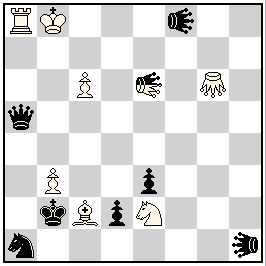 h#2 2 solutions (7+7+1)
White Double-Grasshopper g6
Black Locust f8, Leo h1
Neutral Locust e6
–
Solution:
I. 1.LEh1-h7 Kb8-b7 2.Qa5-e5 nLe6*e5-e4 #
II.1.Qa5-a2 Kb8-c7 2.LEh1-d5 nLe6*d5-c4 #
–
У белых готова прямая батарея DGg6-c6-b3, которая активируется любым ходом nLe6. Но уходя nL нападает на две из трех фигур этой батареи (хотелось в трех фазах по циклу нападать, но это не просто). Поэтому нужно блокировать nL по Петкову. Одно блокирование делают черные лео/ферзь, второе – белый король. Потом ферзь/лео подставляются чтобы сыграла батарея. Т.е. роли bQ & bLE чередуются. Порядок черных ходов мотивируем снятием контроля с поля блокирования на которое идет белый король.
1.LEh1-h7 (blocking h7, unguarding b7) Kb8-b7 (blocking b7) 2.Qa5-e5 (creating hurdle, opening a8-a2) nLe6*e5-e4 # (opening g6-c6, guarding c2) 1.Qa5-a2 (blocking a2, unguarding c7, opening a8-a3) Kb8-c7 (blocking c7) 2.LEh1-d5 (creating hurdle) nLe6*d5-c4 # (opening g6-c6, guarding c2) (Author) |
The diagrams are made on WinChloe and it’s Echecs font is used for Logo design.


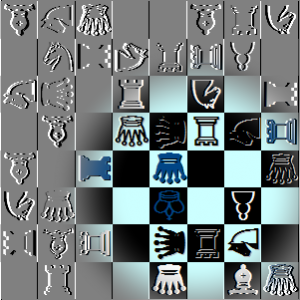
Juraj’s problem is very interesting. Though based on the blocking of the neutral Locusts, the logic of the problem is quite complex. It takes some time to understand how/why the different threats of the try and key become the white second move after the same black defence! The changed and transferred white moves are a surprise. Top class !!
А nice miniature from Janos Mikitovics! But in my opinion some important conclusions and explanations are needed here. First of all, it is necessary to speak about the twin: here the King`s moves are not the standard blocks – more correctly is to say, that the King closes lines for the neutral Locust which cannot play on f7/g7! In thematical aspect this play is also interesting and even better as play in a) position because in b) an important additional motive exists – the King opens line for the white Lion but closes line for the neutral Locust (Bivalve – theme!)
But as general value, this problem with twins has a big minus – full repetition of black moves and mates in both twins. Obviously here is also possible to replace the white Lion with Rook-Lion. In conclusion: in my opinion, the author can publish his problem without twins – only position with wKd6 (with Rook- Lion on f6).
Petko! Many thanks for your help! Yes, the ‘version b’ is the better setting. Julia! Please, publish this problem as Petko A. Petkov correction or as a co-problem with Petko, if he accept it:
White Kd6 GIe6 RLf6
Black Ka6 Sa1
Neutral Lb6
Stipulation H#2** ( 3 + 2 + 1 )
1…Kd6-e5 2.Sa1-b3 nLb6*b3-b2 #
1.Sa1-c2 Kd6-d5 2.Sc2-b4 + nLb6*b4-b3 #
(Bivalve – theme)
Thank you in advance!
Janos
[img]http://www.magyarsakkszerzok.com/JM.jpg[/img]
Janos, the problem is published, No.11. Thank you very much for the interesting discussion we have!
Well…. the solution needs to corrected.
Sorry, it’s my mistake! Corrected!!
I quite like this workshop approach. Soon after the position is published some important remarks on the content and construction are presented. It just requires a few interested commentators, so far they are available. Well done.
Another way of working with idea is abandoning the Bi-valve effect pointed by Petko in exchange for the third phase. E.g. the following position is possible:
White Ka6 RTc6 GIc5 Pc4
Black Kc1 Sg1
Neutral Lc2
h#2
0.1.1.1 + 2.1.1.1
RT = rabbit (in Popeye terminology) = kangaroo lion (in WinChloe terminology, but it should be in French, right now I cannot remember the translation)
1…Ka6-b6 2.Sg1-e2 nLc2*e2-f2 #
1.Sg1-h3 Ka6-b7 2.Sh3-f2 nLc2*f2-g2 #
1.Sg1-f3 Ka6-b5 2.Sf3-d2 nLc2*d2-e2 #
Dear Juraj,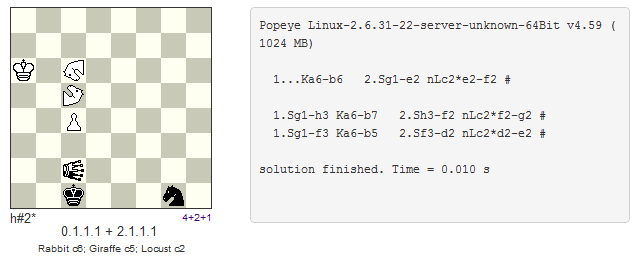 [/img]
[/img]
Thank you very much for your activity!! Thanks to you there’s a lot to see and to discuss! Let me illustrate your notation on the diagram:
[img
Nice version, adding a third solution improves the interesting idea of Janos. Well done !!
This was my version ! (abandons the blocks, but black checks add interest).
#2 Two solutions.
W: Kd2, Pd3, Blion e2,
B: Ka6, Qg1, Ba7, Ps a5 f2 g2.
Neutral Locust b5.
Solutions:
1.Qg1-a1 Kd2-c2 2.Qa1-b2 + nLb5*b2-b1 #
1.Qg1-b1 Kd2-c3 2.Qb1-b4 + nLb5*b4-b3 #
Dear Seetharaman,
Please, see your idea with 2 bB-promotions:
White Sc6 Kd2 Pe2 BLf1
Black Ka6 Pc2
Neutral Lb5
( 4 + 2 + 1 )
Stipulation H#2
b) Pc2Kd2
a) 1.c2-c1=B + Kd2-e1 2.Bc1-b2 nLb5*b2-b1 #
b) 1.d2-d1=B + Kc2-d2 2.Bd1-b3 nLb5*b3-b2 #
Janos
Nice idea, but for the twinning.
Dear Juraj,
Congratulations on your excellent idea!
Janos
Juraj`s position is a pfect development of already familiar mehanism! Cingratulations! An interesting question: who would be author of this excellent problem? Probably – Juraj & Janos?
Dear Seetharaman,
Here is a newer version with (S+B) promotions in 2.1.1… form:
White BLh6 GIc5 Pg5 Kh4
Black Ph2 Kc1
Neutral Ld2
( 4 + 2 + 1 )
Stipulation H#2
1.h2-h1=S Kh4-g4 2.Sh1-f2 + nLd2*f2-g2 #
1.h2-h1=B Kh4-h5 2.Bh1-g2 nLd2*g2-h2 #
Janos
This is very neat with two different promotions of same pawn!
I wonder if so many fairy elements are really needed to show the geometry and battery mate by capture by neutral piece that moves and captures differently?
Here’s my version, i must be missing the whole idea:
Stipulation h#1.5
Pieces
white Ke8 Rh8
black Pb6a7 Ka8 LEc4
neutral LEb8
1…Ke8-d7 2.LEc4-b5 nLEb8*b5 #
1…Ke8-e7 2.LEc4-b4 nLEb8*b4 #
1…Ke8-f7 2.LEc4-b3 nLEb8*b3 #
Your version nice with Leos only! Actually Petko’s idea was to show the blocking of Neutral battery piece(s) — see Part 1/2 of his article. I was the one who sidetracked the discussion showing that a related idea of shut-off is also possible (in his scheme no. 10 in Part 2 of the article)
Dmitry,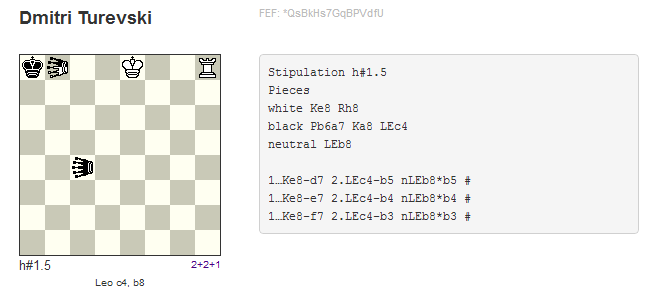 [/img]
[/img]
This is your scheme: [img
Seems like something is wrong with your Leo moves. It captures by hopping over the hurdle. Or do I understand anything wrong?
+wPb6
or
+bPa7 +bPb6
Oh, sorry, yes, it is correct now!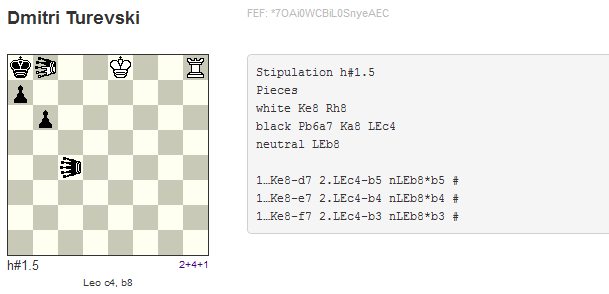 [/img]
[/img]
[img
I’ve left a place on this page for your original! But maybe make it less symmetric?
I suppose you mean “less schematic”. This setting is quite schematic and is more like a geometry study indeed, but frankly, i don’t think it is because it has unnecessary fairy elements removed, it is in original matrix.
Okay, here’s something original (i hope). Doublegrasshopper / Locust battery with two blocks of a single locust. This is a very quick composition, i suppose many improvements are possible:
D.Turevski original for https://juliasfairies.com/, 12-05-2012
[img]http://www.yacpdb.org/misc/hx2-20120512.png[/img]
h#2 2.1.1.1
a8: Pao, e6: Locust, g6: Double Grasshopper, h1: Leo
1.LEh1-h7 Kb8-b7 2.Qa5-e5 nLe6*e5-e4 #
1.Qa5-a2 Kb8-c7 2.LEh1-d5 nLe6*d5-c4 #
Better version (another locust instead of unthematic Pao):
Pieces
white Bc2 DGg6 Kb8 Pb3c6 Se2 Ra8
black LEh1 Kb2 Lf8 Qa5 Pd2e3 Sa1
neutral Le6
Added, No.11, thanks! Please check if everything is ok! I’m trying to do everything faster, and do mistakes as a result. Hope, not this time! julia.
Very nice problem Dmitri. Two different blocks by white king, and change of function of Leo h1 and black queen. Just what Petkov hoped I think !
Thank you, Seetharaman! Coming to think of your previous comment, it seems that blocks of a locust are more valuable than shutoffs. First, these blocks are pure fairy effects, while shutoffs are orthodox in nature, but more imortantly, there’s a whole line where you can perform a shutoff, but just a single square for a block which leaves less degrees of freedom for composer when looking for the scheme of the problem.
Dear Julia,
You’re right! The problem is solvable also without a twin.
Janos